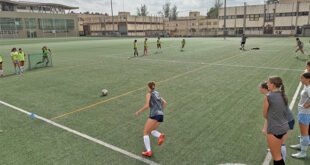I’ve tried to make sense of the mayhem on the track and, truth be told, it’s tough. But here are some quick tips, compliments of the Women’s Flat Track Derby Association to maybe help you when you’re at the “bout” this Saturday at 6 p.m. at Big Mine Ice Arena in Crested Butte.
Enjoy the hitting. Let’s admit it, the first time you go to a roller derby bout, you’re looking for big hip-checks and skaters sprawling to the floor. That’s okay! To rip off Yogi Berra, 50 percent of this sport is half-physical, so enjoy the big hits and the big falls.
Watch the jammers. They score the points, and they’re the ones who get hit most often. They’re also easy to spot because they’re wearing a big star on their helmets. The blockers will mostly focus on them, so you should too.
Watch the pack even when the jammers aren’t there. This is the equivalent of watching the action “off the ball” in most sports: how a basketball half-court offense sets up, or a football defensive scheme. Watch who’s moving to the front and who’s dropping back. Watch how the pack speeds up and slows down depending on where the jammers are. Watch for the refs to signal where the pack is when it starts to split, and how it reforms when that happens.
Watch the referees. A good referee is part of the action. Pack refs follow the pack and signal penalties. Jam refs follow the jammers and count points with a raised hand after each scoring pass. Watch for a five-point “grand slam,” when a jammer passes all blockers and laps the opposing jammer. You can learn all the other penalty calls on WFTDA.com, which shows pictures of all the calls.
Watch the penalty box. When a team has blockers in the box, opposing jammers have the opportunity to score points more easily. When a team’s jammer is in the box, she can’t score at all! Penalties last for one minute; when a skater has 10 seconds remaining in the penalty box, she stands up to prepare to re-enter the pack.
Watch the blockers who aren’t in the pack. The “20 foot rule” is one of the little details that comes into play a lot on the track. It’s like the offside rule in soccer—hard to understand, but used strategically and an important part of understanding the game. When blockers get too far ahead of the pack because they’re fighting off a jammer, look for the “out of play” warning (ref’s right arm bends at the elbow with the hand straight up) and penalty (the hand comes down in a chopping motion), or listen for the call, “20 feet! Let her go!”
Try to understand the strategy. Why did the lead jammer call off that jam? How much time is left in the period? What’s the score? Which jammers get ahead on speed, and which get ahead by letting their blockers do the work? Which blockers seem to rely on hard hits and which rely on positional blocking to stop opponents or clear a path for their own jammer? How do blockers work together to stop a jammer? How does a jammer get help from the blockers on her team? How quickly does a team shift from offense to defense depending on their jammer’s position—do certain skaters seem to always play one or the other?
Count jammer points. See if you can tally how many opposing skaters a jammer has passed legally. Don’t forget, they get points for any players in the penalty box as soon as they pass the first opponent on the track. You might not always get the same number as the jam ref, because you might not always see penalties (which result in points not being granted). But the first time you call a grand slam before the jam ref signals it, the look of awe from your friends will make it worthwhile.
 The Crested Butte News Serving the Gunnison Valley since 1999
The Crested Butte News Serving the Gunnison Valley since 1999


